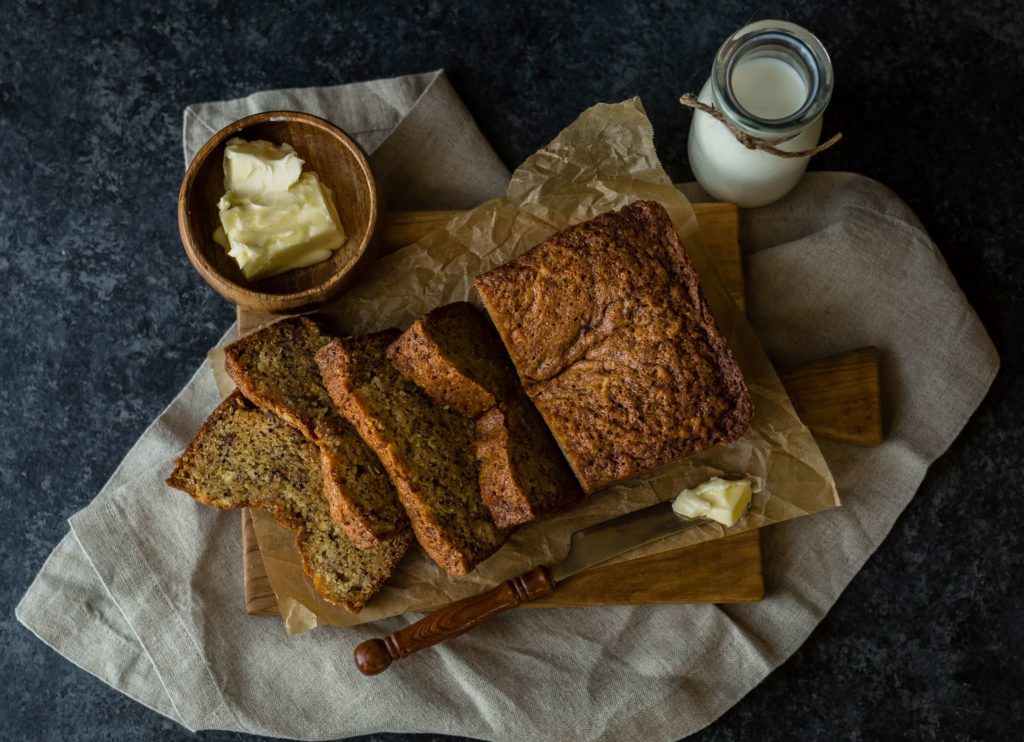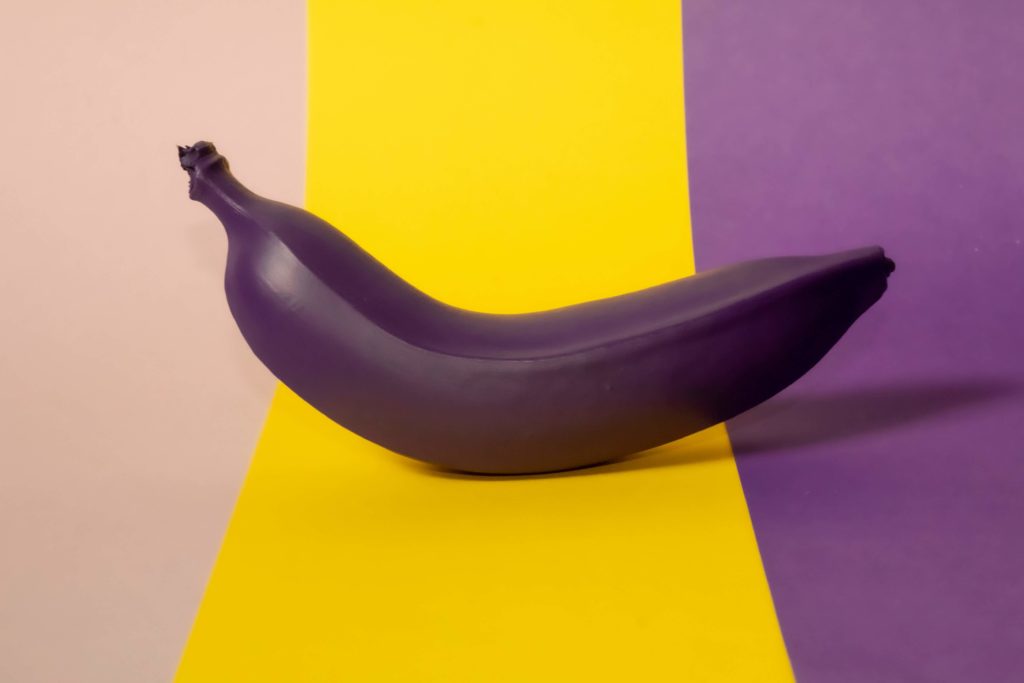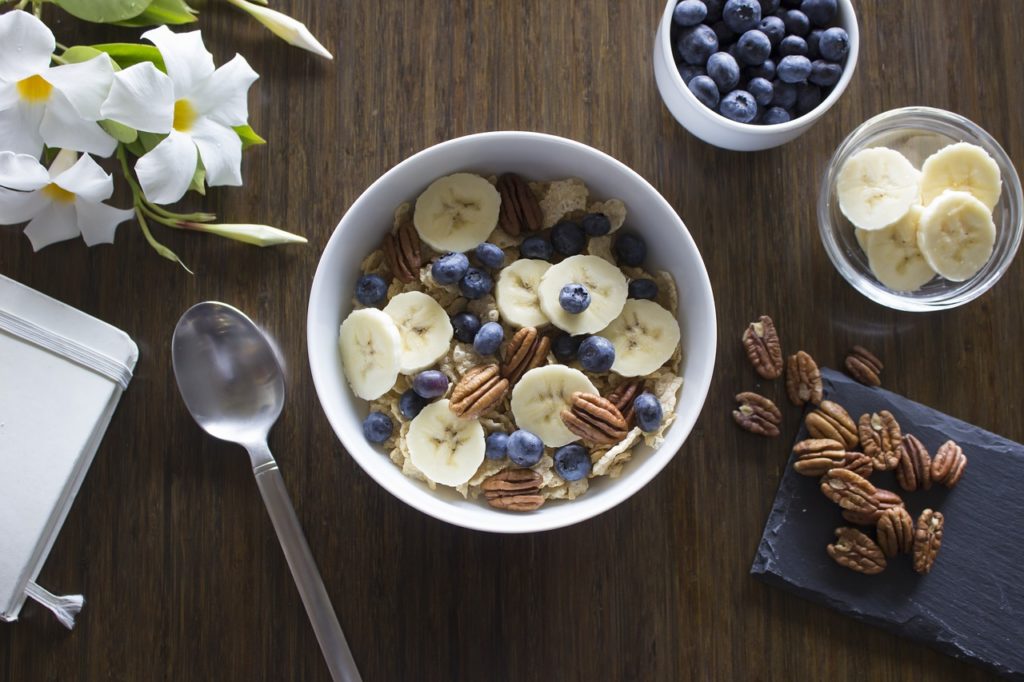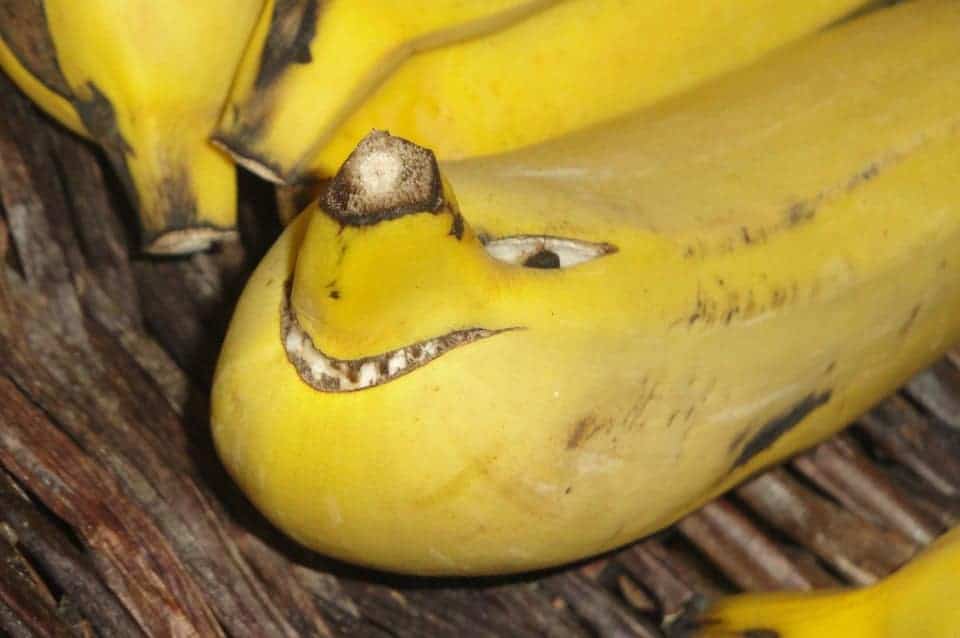Want an easy banana bread recipe to make the best banana bread ever? There are a few reasons we love this recipe.

It’s very quick to make. Before your oven preheats, you’ll already have everything prepared to make your banana bread.
The ingredients needed are typically already in your home, so you won’t even have to take a trip to the grocery store.
This simple banana bread recipe turns out perfect each and every time you bake it. It’s hard to mess up, we promise!

Not only is it easy to make, but this banana bread also comes out perfectly moist with the most delicious flavor ever.
Let’s get started.
Our Easy Banana Bread Recipe
Here is a simple and delicious banana bread recipe that you can try at home:
Ingredients:
- 1 1/2 cups all-purpose flour
- 1 teaspoon baking soda
- 1/4 teaspoon salt
- 1/2 cup unsalted butter, melted
- 3/4 cup granulated sugar
- 2 large eggs, lightly beaten
- 1 1/2 cups mashed ripe bananas (about 3 large bananas)
- 1 teaspoon vanilla extract
Instructions:
- Preheat your oven to 350°F (180°C) and lightly grease a 9×5-inch loaf pan.
- In a medium-sized mixing bowl, whisk together the flour, baking soda, and salt.
- In a separate large mixing bowl, beat together the melted butter and sugar until well combined. Add the eggs, mashed bananas, and vanilla extract, and beat until smooth.
- Add the dry ingredients to the wet ingredients and stir until just combined. Pour the batter into the prepared loaf pan and smooth the top.
- Bake the banana bread for 55-65 minutes, or until a toothpick inserted into the center comes out clean. Let the bread cool in the pan for 10 minutes, then turn it out onto a wire rack to cool completely.
Enjoy your banana bread! You can serve it as is, or slice it and serve it with butter or your favorite spread. It also goes well with a cup of coffee or tea.
What Are the Typical Ingredients for Banana Bread?
Banana bread is a classic, comforting treat that can be enjoyed for breakfast or dessert. To make your own delicious banana bread, you’ll need the following key ingredients: flour, sugar, eggs, butter/oil (or vegan alternative), baking powder and of course bananas!
To start off with your recipe you’ll need to preheat your oven to 350 degrees Fahrenheit then mix together all of the dry ingredients in one bowl while mashing up ripe bananas in another bowl. Next add melted butter/oil (or vegan alternative) into the mashed banana mixture along with any desired extras such as walnuts or chocolate chips before combining both mixtures together until it forms a batter-like consistency.
Once everything is mixed together pour it into an appropriately sized loaf pan and bake for 45 minutes – 1 hour until golden brown on top. After allowing time to cool enjoy your homemade banana bread warm or at room temperature!
Is Baking Soda Necessary in Banana Bread?
Baking soda is an important ingredient when it comes to making banana bread. Not only does the baking soda help with aeration and leavening, but it also helps produce a light and fluffy texture that we all love in this classic treat.
Baking soda adds a slight tanginess as well, which can be balanced out by adding other flavorings like cinnamon or nutmeg to the batter. It also helps brown up the crust of the finished product for a pleasant look and taste—something that would not happen without baking soda!

So yes, if you’re planning on making delicious banana bread at home, don’t forget about including baking soda as part of your ingredients list! You won’t regret it!
Can You Use Really Ripe Bananas for Banana Bread?
Can you use really ripe bananas for banana bread? The answer is yes! In fact, overly ripe bananas are the best choice for making a delicious and moist banana bread. Overripe bananas have sweeter flavors due to their higher levels of natural sugars, which can provide an added sweetness that helps make your finished product even more flavorful.
Additionally, super soft and broken down overripe fruit makes it easier to mash up all of the ingredients together, creating a much smoother texture in your final product than unripened or barely ripened fruits may give.
As such, when selecting your perfectly sweet and gooey ingredients for baking some banana bread goodness—be sure to grab those brown spotted beauties from the bunch!
Do You Put Eggs in Banana Bread?
Banana bread is one of the most popular quick breads out there – and there’s no question why. It has a delicious, sweet flavor that pairs perfectly with coffee or tea. But when it comes to ingredients, should you add eggs to your banana bread recipe?
The answer depends on what type of texture you’re looking for in the finished product. While some recipes call for eggs as an ingredient (which will result in a denser loaf), other recipes are egg-free and produce light and fluffy loaves instead.

« How to Keep Bananas Fresh After Peeling Them: 5 Proven Methods
How Many Bananas is Too Many to Eat? »
If you prefer a lighter texture, then skip adding the egg altogether; if not, make sure to include an egg (or two) into your batter before baking!
How Many Bananas Are in 2 Cups?
When it comes to determining how many bananas are in 2 cups, the answer will depend on a variety of factors. The size of the banana matters, as well as whether or not they have been peeled.
For example, if you are measuring two cups of small unpeeled bananas then you could expect around 12-15 pieces per cup; while larger peeled bananas might yield 8-10 pieces per cup instead.
It is also important to consider that some recipes may call for an exact number of whole or sliced banana pieces and so accuracy can be key when measuring out fruit for cooking or baking applications.
Therefore using scales and other tools such as guides with measurements should be taken into consideration when trying to determine the exact amount needed for a recipe.
Additionally, potential waste must also be considered when attempting to achieve accurate measurements – especially if there is only a specific number required from each batch due to budget constraints, etc. Hereby ensuring every piece is accounted for downgrades any wastage consumed by spoilage/accident-related incidents along with allowing rationing where necessary depending on usage demand requirements (eagerly measured).
Can I Use Baking Powder Instead of Baking Soda for Banana Bread?
Baking soda and baking powder are often used interchangeably in recipes, however, they are not the same. Baking powder is made up of a combination of baking soda, cream of tartar and sometimes cornstarch.
It’s a type of leavening agent that creates lightness in dough by producing carbon dioxide gas when it reacts with water or heat. On the other hand, baking soda is pure sodium bicarbonate which needs an acid to create CO2 — like vinegar or even yogurt if you want to make pancakes!
When making banana bread specifically, it would be best to use baking powder instead of just plain baking soda as there may not be enough naturally occurring acids present (like from bananas) for the reaction needed between sodium bicarbonate and an acid to take place properly – resulting in under-leavened banana bread!

It’s also important to note that different brands have different strengths so using too much can result in a bitter taste; also check expiration date before using any ingredients as well.
Is It Better to Use Bread Flour or All-Purpose Flour for Banana Bread?
When baking banana bread, it is important to choose the right type of flour for optimal results. Generally speaking, bread flour works best because of its high protein content which helps create a strong structure.
The gluten in the dough will create air pockets as it rises and give your loaf an even texture. Additionally, using bread flour can help retain moisture better than all-purpose flour giving your finished product a more tender crumb.
However, if you don’t have access to bread flour or prefer not to use it due to dietary restrictions then all-purpose is still a viable option for banana bread recipes – just with slightly reduced results in terms of flavor and texture.
All-purpose flours tend to be lower in protein so they do not hold onto rising gas bubbles as effectively meaning that your final product may have less volume but still taste delicious!
Ultimately when deciding between these two options consider what you’re looking most out of your bake – crunchier crusts? softer crumbs? Then make sure you’ve got the perfect combination ingredients from there!
Can You Put Too Much Banana in Banana Bread?
When it comes to creating the perfect banana bread, one of the most common questions asked is whether you can put too much banana in the mix. The answer is yes – but there are ways to ensure that your end product isn’t overwhelmed with an excess of bananas.
The key when using a large amount of banana in any recipe is balance – not only does this refer to ingredients like sugar and spices, but also textures as well as moisture levels.
If you use more than two ripe bananas for a standard-sized loaf pan, you’ll need extra flour or oats so that your mixture doesn’t become overly wet from all those mashed up bananas.
Additionally, if adding chunks or slices (rather than mushing them into a paste), make sure they’re evenly distributed throughout your batter and dole out some nuts or chocolate chips for added texture contrast; otherwise, it will be “too bready” rather than having enough distinct tastes and textures between different bites!
Do You Wrap Banana Bread in Foil or Plastic Wrap?

When storing banana bread, it is important to wrap the loaf in either foil or plastic wrap. To preserve the flavor and texture of your banana bread, wrapping the loaf tightly helps keep out excess moisture and air from entering.
Wrapping with foil will help protect against any possible freezer burn issues that you may encounter if you plan on freezing your banana bread for later use. Foil also helps retain heat so when reheating, there’s less time spent waiting for a warm slice of deliciousness.
Plastic wrap offers more protection against bacteria growth which can cause spoilage faster than normal if left exposed to open air too long without being properly covered up first. So whichever method you choose depends largely on how quickly or slowly you intend to eat all that yummy goodness!
What Happens If You Forget the Eggs in Banana Bread?
For some recipes, leaving out the eggs in banana bread is a mistake that may result in an undesired texture or flavor. The egg provides moisture and helps give structure to the finished product.
Without it, you’ll end up with a dryer, crumbly cake-like texture instead of light and fluffy banana bread. Eggs also add richness to banana bread by providing extra fat content which helps keep it moist for longer periods of time after baking.

The other ingredients like bananas, flour and butter can still produce a delicious loaf without eggs but will likely suffer from lower rising potential due to lack of leavening power from the egg whites as well as some loss in flavor composition depending on how much sugar is added into the mix too soon before baking begins (sugar acts as natural tenderizer).
Ultimately though what happens if you forget your eggs depends heavily on your recipe itself so be sure read carefully prior each attempt!
Final Conclusion
With proper ingredients and steps, banana bread can be a delicious treat that’s easy to make. We hope this article has answered all of your questions on what are the ingredients for banana bread, baking soda needs in banana bread and other details.
So don’t hesitate – gather up those super ripe bananas you have lying around and begin baking! If you still have any doubts or concerns about making the perfect loaf of banana bread, feel free to reach out with any further questions.
Happy baking!













